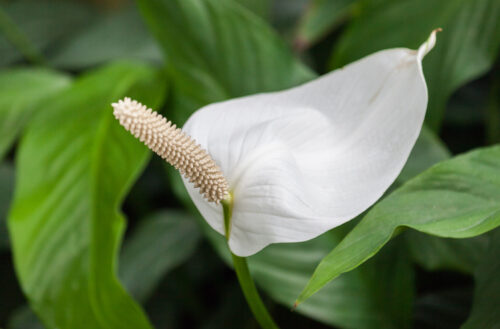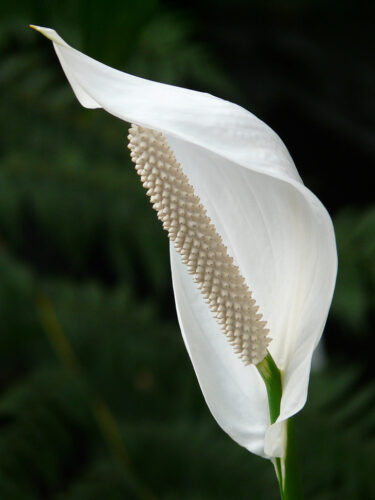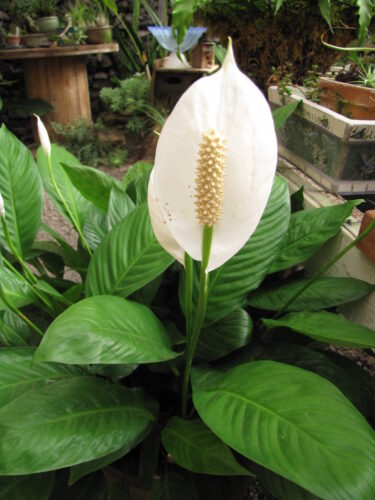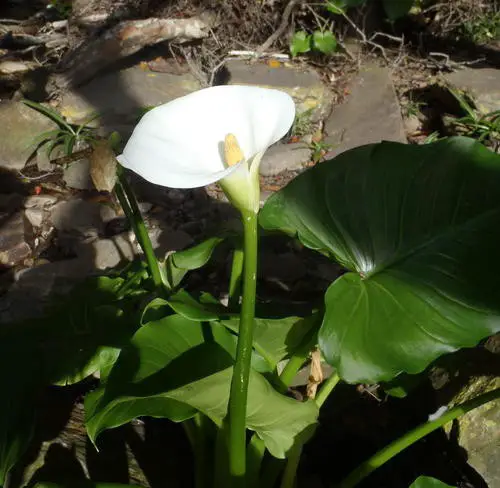Answer: Peace Lilies, scientifically known as Spathiphyllum sp, are mildly toxic to cats. While not as dangerous as true lilies, they contain insoluble oxalates in all parts, causing discomfort if ingested. Immediate symptoms include drooling, swelling, and irritation. Although generally manageable with first aid measures, such as using cool demulcents like yogurt, severe cases may require veterinary attention.
The Peace Lily, scientifically known as Spathiphyllum sp, is a popular indoor flowering plant from the Araceae family. Cat owners often express concerns about its potential toxicity, given its name similarity to toxic lilies like Lilium and Hemerocallis. This article aims to provide a comprehensive guide on the safety of Peace Lilies for cats, addressing common questions, debunking myths, and offering practical advice for pet owners.
Peace Lilies vs. Toxic Lilies
To differentiate between Peace Lilies and toxic lilies, it’s crucial to understand their botanical classifications. Peace Lilies, belonging to the Araceae family, are distinct from Lilium and Hemerocallis, which fall into the Lilium genus. The misconception that all plants with “lily” in their name pose a high toxicity risk needs clarification. Peace Lilies are not true lilies, and this section will delve into the scientific distinctions that set them apart.
1. Botanical Classification
Peace Lilies (Spathiphyllum) and toxic lilies (Lilium, Hemerocallis) belong to different plant families.
- Peace Lilies: Araceae family.
- Toxic Lilies: Lilium genus within the Liliaceae family.
2. Name Similarity
The common name “lily” in Peace Lily can cause confusion, but it’s crucial to recognize that the danger lies in specific lily species.
- Peace Lilies are not true lilies and differ significantly in terms of toxicity.
3. Peace Lilies: A Mild Concern
While Peace Lilies are not entirely without harm, their toxicity level is considerably lower than that of true lilies.
- Understanding the mild nature of Peace Lily toxicity.
- Comparing the risks associated with Peace Lilies to toxic lilies.
Are Peace Lily Toxic to Cats

Peace Lilies, scientifically known as Spathiphyllum sp, are mildly toxic to cats. While not as dangerous as true lilies, they contain insoluble oxalates in all parts, causing discomfort if ingested. Immediate symptoms include drooling, swelling, and irritation. Although generally manageable with first aid measures, such as using cool demulcents like yogurt, severe cases may require veterinary attention.
Peace Lilies contain microscopic needle-like crystals called insoluble oxalates in all parts of the plant. When a cat chews on or swallows these crystals, it can lead to immediate discomfort and symptoms such as drooling, excessive licking, vomiting, and difficulty swallowing. This section will elaborate on the specific aspects of Peace Lily toxicity and its potential effects on cats.
1. Oxalate Crystals in Peace Lilies
Insoluble oxalates are present in all parts of the Peace Lily, causing an immediate burning sensation when in contact with a cat’s mouth and tongue.
- Explaining the nature of insoluble oxalates.
- How oxalate crystals differ from the toxic components in true lilies.
2. Immediate Effects on Cats
Cats may exhibit various symptoms after ingesting or coming into contact with Peace Lilies.
- Identifying common signs of Peace Lily poisoning.
- Steps to recognize and address immediate effects on cats.
3. Severity of Peace Lily Toxicity
Unlike true lilies that pose a significant risk of kidney damage, Peace Lilies primarily cause mild reactions.
- Clarifying the limited severity of Peace Lily toxicity.
- Understanding the absence of kidney damage concerns.
First Aid and Immediate Actions

In case of suspected Peace Lily poisoning, prompt actions are crucial. This section outlines the steps to take for first aid and immediate response. It also emphasizes the importance of seeking professional advice from the Animal Poisons Centre.
1. Contacting the Animal Poisons Centre
The first step in a potential poisoning situation is to contact the Animal Poisons Centre for expert advice.
- Providing contact details: 1300 869 738 (Australia) or 0800 869 738 (New Zealand).
- Why immediate consultation is vital for accurate guidance.
2. First-Aid Measures
Immediate actions at home can help alleviate symptoms and reduce the impact of Peace Lily toxicity.
- Recommending cool demulcents like yogurt or lactose-free milk.
- Addressing rare cases of severe reactions and airway swelling.
3. Risk Assessment
The Animal Poisons Centre conducts a risk assessment to determine the severity of the situation and guide further steps.
- Understanding the factors considered in a risk assessment.
- Importance of providing detailed information about the incident.
Peace Lilies and Pets
This section reiterates the overall safety of Peace Lilies for cats while acknowledging that caution is still necessary, especially if a cat is prone to chewing on plants. It provides insights into the general behavior of pets towards Peace Lilies and the level of toxicity associated with ingestion.
1. Comparing Peace Lilies to Toxic Lilies
Peace Lilies pose significantly less risk compared to true lilies, making them a safer option for households with cats.
- Emphasizing the importance of distinguishing between Peace Lilies and toxic lilies.
- Addressing the concerns of cat owners.
2. Mild Toxicity of Peace Lilies
While Peace Lilies are not entirely pet-safe, their toxicity is generally mild, causing minor reactions in most cases.
- Detailing the mild nature of Peace Lily toxicity.
- Common reactions in pets and their usual outcomes.
3. Caution for Cat Owners
Owners of cats that are prone to chewing on plants should exercise caution and consider alternatives to Peace Lilies.
- Identifying behaviors that indicate a higher risk of ingestion.
- Alternatives for cat owners with plant-chewing pets.
Myth-Busting: Peace Lilies and Cat Safety

This section aims to debunk common myths surrounding Peace Lilies and their supposed danger to cats. It provides evidence-based information to reassure cat owners and dispel misconceptions related to plant toxicity.
1. Debunking the “Peace Lilies Kill Cats” Myth
The myth that Peace Lilies can lead to fatal consequences for cats is unfounded and needs clarification.
- Addressing the myth and its origins.
- Providing scientific evidence to counter the misconception.
2. Understanding Mild Toxicity
Acknowledging that while Peace Lilies are not entirely harmless, their toxicity is relatively mild and manageable.
- Differentiating between mild and severe plant toxicity.
- Reinforcing the notion that Peace Lilies are not lethal to cats.
3. Calling for Responsible Information Sharing
Encouraging cat owners to share accurate information about Peace Lilies to dispel myths and prevent unnecessary panic.
- The role of responsible pet ownership in dispelling myths.
- Promoting informed decision-making regarding indoor plants and pets.
FAQs and People Also Ask
This section addresses frequently asked questions and additional queries that commonly arise regarding Peace Lilies and their impact on cats. Each question is answered comprehensively, providing valuable information for cat owners seeking guidance.
What happens if a cat eats a Peace Lily?
Cats may experience mild symptoms, including drooling, swelling, and irritation. In severe cases, vomiting and diarrhea may occur.
Which part of the Peace Lily is poisonous to cats?
All parts of the Peace Lily contain insoluble oxalates, with the highest concentration in the leaves.
Can smelling a Lily hurt a cat?
While smelling a Peace Lily is unlikely to cause harm, direct contact with the plant, such as chewing or licking, can lead to mild toxicity.
How fast is Lily poisoning in cats?
The onset of symptoms can be rapid, typically occurring within a few hours of ingestion.
Can cats recover from Lily poisoning on their own?
In most cases, cats can recover from mild Peace Lily poisoning with proper care. However, severe cases may require veterinary attention.
Treatment for Peace Lily poisoning in cats.
First aid measures include using cool demulcents like yogurt or lactose-free milk. Severe cases may necessitate veterinary intervention.
Overall toxicity of Peace Lilies to pets.
Peace Lilies are considered mildly toxic, causing discomfort but not severe organ damage like true lilies.
Are Peace Lilies safe for pets?
While they are safer than toxic lilies, caution is advised, especially for cats prone to chewing on plants.
What to do if a cat eats a Peace Lily?
Contact the Animal Poisons Centre for guidance and administer first aid measures as recommended.
How to keep cats away from Peace Lilies?
Implement strategies such as placing the plant in areas inaccessible to cats or using pet-safe deterrents.
Additional Tips and Myth-Busting
This section offers additional tips for pet owners, debunking another common misconception about drainage layers in indoor potted plants. It emphasizes the importance of accurate information to ensure the well-being of both plants and pets.
Debunking the Drainage Layer Myth
Contrary to popular belief, adding a drainage layer to indoor potted plants does not enhance drainage and can increase the risk of root rot.
- Explaining the purpose of drainage layers.
- Providing evidence against the effectiveness of drainage layers.
Watering at the Right Time
The article dispels the misconception about the right time to water plants, emphasizing the risks associated with improper watering schedules.
- Explaining the impact of watering at the wrong time on plant health.
- Offering guidance on the ideal time for watering indoor plants.
General Care for Indoor Plants and Pets
Concluding with general care tips, this section highlights the importance of responsible pet ownership and creating a safe environment for both plants and animals.
- Promoting awareness of plant toxicity.
- Encouraging a balanced approach to indoor plant care and pet safety.
Conclusion
In summary, Peace Lilies are not as toxic to cats as true lilies, but caution is still advised. Understanding the distinctions in plant classifications, recognizing mild toxicity, and taking immediate action in case of ingestion are essential for responsible pet ownership. By dispelling myths and providing accurate information, this article aims to empower cat owners to make informed decisions about keeping Peace Lilies in their homes while ensuring the safety and well-being of their feline companions.
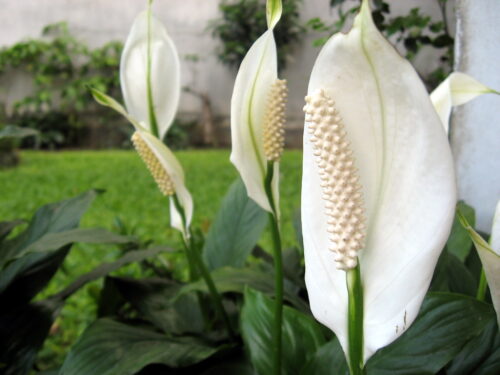
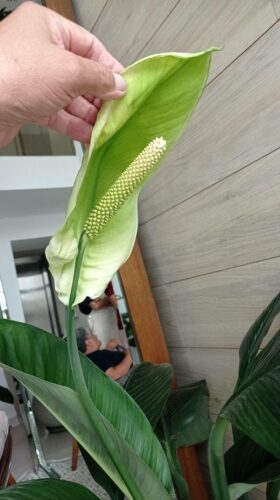
Quiz: Test Your Knowledge on Peace Lilies and Cats
1. What family does the Peace Lily belong to?
a) Liliaceae
b) Araceae
c) Rosaceae
d) Asteraceae
2. Which part of the Peace Lily contains insoluble oxalates?
a) Flowers
b) Leaves
c) Stems
d) Roots
3. True or False: Peace Lilies can cause severe kidney damage in cats.
4. In case of suspected Peace Lily poisoning, what is the recommended first-aid measure for cats?
a) Administering anti-toxin
b) Using cool demulcents like yogurt
c) Inducing vomiting
d) Providing pain medication
5. What distinguishes Peace Lilies from toxic lilies like Lilium and Hemerocallis?
a) Botanical family
b) Flower color
c) Number of petals
d) Leaf shape
6. Which myth is addressed in the article regarding Peace Lilies and cats?
a) Peace Lilies cause kidney failure in cats
b) Peace Lilies are entirely harmless to cats
c) Peace Lilies can be fatal to cats within days
d) Peace Lilies have no toxic components
7. What is the role of the Animal Poisons Centre in a potential Peace Lily poisoning incident?
a) Providing medical treatment
b) Offering plant care advice
c) Conducting a risk assessment
d) Dispelling myths about plant toxicity
8. Why is caution advised for cat owners with Peace Lilies, even though they are mildly toxic?
a) Cats may develop allergies to Peace Lilies
b) Cats are attracted to the fragrance of Peace Lilies
c) Some cats may exhibit no reaction at all
d) Cats are prone to severe respiratory issues
9. What is the purpose of a drainage layer in indoor potted plants, according to the article?
a) Enhancing plant growth
b) Preventing root rot
c) Deterring pests
d) Increasing water retention
10. When is the ideal time to water indoor plants, as emphasized in the article?
a) Morning
b) Afternoon
c) Evening
d) Night
Answers: 1 – b, 2 – b, 3 – False, 4 – b, 5 – a, 6 – c, 7 – c, 8 – c, 9 – b, 10 – a
